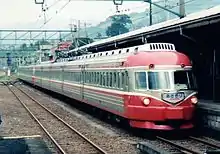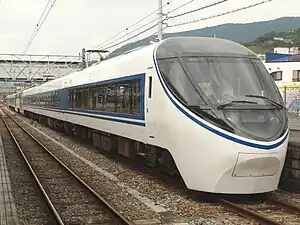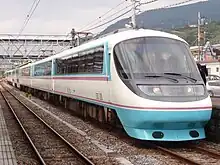 An Odakyu 60000 series EMU on an Asagiri service, April 2012 | |
| Overview | |
|---|---|
| Service type | Limited express |
| Status | In operation |
| Locale | Tokyo, Kanagawa and Shizuoka, Japan |
| Predecessor | Asagiri |
| First service | 1 May 1959 (Semi-express) 1 July 1968 (Express) 16 March 1991 (Limited express) |
| Current operator(s) | Odakyu Electric Railway |
| Former operator(s) | JNR, JR Central |
| Route | |
| Termini | Shinjuku Gotemba |
| Stops | 8 |
| Service frequency | 3/4 return workings daily |
| Line(s) used | Odakyu Odawara Line, JR Central Gotemba Line |
| On-board services | |
| Class(es) | Standard class only |
| Disabled access | Yes |
| Seating arrangements | 2+2 forward facing |
| Sleeping arrangements | None |
| Catering facilities | Vending machines only |
| Entertainment facilities | None |
| Other facilities | Toilets |
| Technical | |
| Rolling stock | Odakyu 60000 series MSE EMUs |
| Track gauge | 1,067 mm (3 ft 6 in) |
| Electrification | 1,500 V DC overhead |
| Operating speed | 110 km/h (70 mph) |
| Track owner(s) | Odakyu Electric Railway, JR Central |
The Mt. Fuji (ふじさん, Fujisan) (formerly known as the Asagiri (あさぎり) prior to 17 March 2018) is a "Romancecar" limited express train operated by Odakyu Electric Railway between Shinjuku and Gotemba via the Odakyu Odawara Line and JR Central's Gotemba Line.[1]
Route
Mt. Fuji services stop at the following stations:[2]
Shinjuku – Shin-Yurigaoka – Sagami-Ono – Hon-Atsugi – Hadano – Matsuda – (Suruga-Oyama) – Gotemba
- The outbound Mt. Fuji No. 1 and No. 3 travel to Gotemba, and the inbound Mt. Fuji No. 6 travels to Shinjuku at the evening stop at Suruga-Oyama. When boarding a Mt. Fuji train at Suruga-Oyama, a limited express ticket must be purchased from onboard train crew.
Rolling stock
- Odakyu 60000 series MSE 6-car EMUs (since 17 March 2012)
Past
- Odakyu KiHa 5000 series and KiHa 5100 series DMUs (July 1959 – June 1968)[3]
- Odakyu 3000 series SSE EMUs (July 1968 – March 1991)
- JR Central 371 series 7-car EMU (March 1991 – 16 March 2012)
- Odakyu 20000 series RSE 7-car EMUs (March 1991 – 16 March 2012)
 KiHa 5000 series DMU car
KiHa 5000 series DMU car KiHa 5100 series DMU car
KiHa 5100 series DMU car Odakyu 3000 series SSE, 1991
Odakyu 3000 series SSE, 1991 JR Central 371 series, October 2009
JR Central 371 series, October 2009 Odakyu 20000 series RSE, October 2009
Odakyu 20000 series RSE, October 2009
History
Kyushu Asagiri
The Asagiri (あさぎり) name was first used from 1 May 1959 for a JNR semi-express operating between Moji and Amagase in Kyushu.[4] This service was upgraded to "Express" status from 5 March 1966.[4] It was discontinued from 1 October 1980.[5]
Gotemba Line Asagiri
A second Asagiri service, initially written in kanji as "朝霧" commenced on 2 July 1959 as a semi-express operating between Shinjuku and Gotemba.[4] The Asagiri, together with the Nagao (長尾), supplemented the Ginrei (銀嶺) and Fuyō (芙蓉) Shinjuku—Gotemba semi-express services, which commenced on 1 October 1955.[3] Asagiri services were upgraded to "express" status from 1 July 1968 following electrification and the introduction of Odakyu 3000 series SE EMUs. The four names were also merged into "あさぎり" in hiragana.[4] It became a "Limited express" from 16 March 1991 with the introduction of new JR Central 371 series and Odakyu 20000 series RSE 7-car EMUs, operating between Shinjuku and Numazu.[5]
March 2012 timetable revision
From the start of the revised timetable on 17 March 2012, the Odakyu 20000 series sets and JR Central's lone 371 series set were withdrawn, and all services were operated instead using Odakyu 60000 series MSE 6-car sets.[6][7] From the same date, service frequency was reduced from the current four return services daily to three on weekdays and four at weekends, and all services were truncated to operate between Shinjuku and Gotemba stations.[7]
March 2018 timetable revision
From the start of the revised timetable on 17 March 2018, Asagiri services are renamed Mt. Fuji (ふじさん).[8]
References
- ↑ JR新幹線&特急列車ファイル [JR Shinkansen & Limited Express Train File]. Japan: Kōtsū Shimbun. 2008. p. 30. ISBN 978-4-330-00608-6.
- ↑ こだわりの新幹線&特急列車ガイド [In-depth Shinkansen & Limited Express Guide]. Japan: Ikaros Publishing. August 2000. pp. 92–93. ISBN 4-87149-284-2.
- 1 2 Miyake, Toshihiko (June 1991). "あさぎり"三代記 [Three Generation Story of Asagiri]. Japan Railfan Magazine. Kōyūsha (362): 58.
- 1 2 3 4 Teramoto, Mitsuteru (July 2001). 国鉄・JR列車名大辞典 [JNR & JR Train Name Encyclopedia]. Tokyo, Japan: Chuoshoin Publishing Co., Ltd. pp. 62–64. ISBN 4-88732-093-0.
- 1 2 列車名鑑1995 [Train Name Directory 1995]. Japan: Railway Journal. August 1995. p. 48/123.
- ↑ 「371系」来春引退 JR東海の特急「あさぎり」 [JR Central 371 series Asagiri limited express to be withdrawn next spring]. @Shizuoka (in Japanese). Japan: The Shizuoka Shimbun and Shizuoka Broadcasting System. 18 October 2011. Archived from the original on 20 October 2011. Retrieved 18 October 2011.
- 1 2 2012年3月17日(土) ダイヤ改正を実施します。 [Timetable Revision Takes Effect from Saturday 17 March 2012] (PDF). News Release (in Japanese). Japan: Odakyu Electric Railway. 16 December 2011. Retrieved 16 December 2011.
- ↑ 新ダイヤでの運行開始日を決定! [Start of revised timetable] (PDF). News release (in Japanese). Japan: Odakyu Electric Railway. 15 December 2017. Archived (PDF) from the original on 15 December 2017. Retrieved 15 December 2017.
External links
- Odakyu Limited Express Romancecar information
- JR Central 371 series Asagiri information at the Wayback Machine (archived 28 April 2010) (in Japanese)